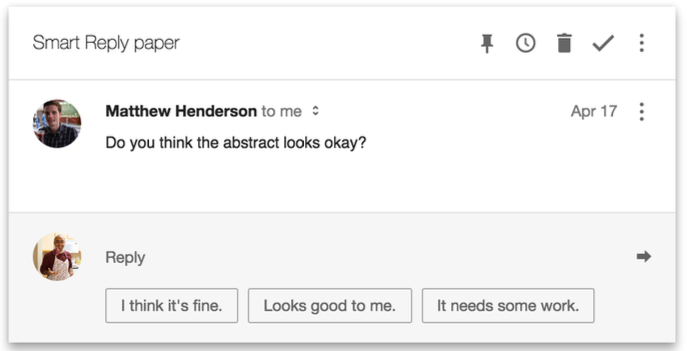update from Ray Kurzweil | His plans for smart language software at Google
August 10, 2017

Smart Reply (credit: Google Research)
— the update —
Ray Kurzweil is a best selling author, tech inventor and futurist. Over the course of his career he’s started many pioneering projects. Now, as a director of engineering at Google, he’s leading a team to create computerized language systems that can track human conversations and suggest realistic dialog — a tool that’s being added to a range of Google’s products.
The primary software tool he’s co-developed is called Smart Reply. The tool is now part of of Google’s suite of e-mail + mobile texting products. It watches while you type, and also watches text come in from the person who’s talking to you. When it’s time for you to reply in the dialog, it suggests several human-like phrases that make good sense — so you can pick one, and that reply is automatically sent back to your conversation partner. The receiver can’t tell that a software tool wrote the reply. It’s indistinguishable from a actual human. If you don’t mention that you’re using Smart Reply, your friend would never be able to tell the difference.
Smart Reply was launched on Google’s products: mobile G-mail and Google Inbox.
on the web | reading
Wired | What is Ray Kurzweil up-to at Google?
deck: Writing your e-mails.
date: August 2, 2017
— better auto-complete —
His team at Google is currently working on the ability for the tool to expand the answers it suggests.
“Tapping a Continue button [in response to an email] might cause ‘Sure I’d love to come to your party!’ to expand to include, for example, ‘Can I bring something?’ He likes the idea of having AI pitch in anytime you’re typing, a bit like an omnipresent, smarter version of Google’s search autocomplete. ‘You could have similar technology to help you compose documents or emails by giving you suggestions of how to complete your sentence,’ Kurzweil says.”
As Simonite notes, Kurzweil’s software is based on his hierarchical theory of intelligence, articulated in Kurzweil’s latest book, How to Create a Mind and in more detail in an
arXiv paper
author: by Ray Kurzweil + Google team
The paper further explains that Smart Reply previously used a “long short-term memory” (LSTM) network*, “which are much slower than feed-forward networks [used in the new software] for training and inference” because with LSTM, it takes more computation to handle longer sequences of words.
Kurzweil’s team was able to produce email responses of similar quality to LSTM, but using fewer computational resources by training hierarchically connected layers of simulated neurons on clustered numerical representations of text. Essentially, the approach propagates information through a sequence of ever more complex pattern recognizers until the final patterns are matched to optimal responses.
— linguistically fluent software —
Kurzweil said: “Underneath Smart Reply is a system for understanding language. Google has the goal of creating software as linguistically fluent as you or me. I wouldn’t say it’s at human levels, but I think we’ll get there. More applications are coming soon to Google’s range of products.”
reference:
Matthew Henderson, Rami Al-Rfou, Brian Strope, Yun-Hsuan Sung, La ́szlo ́luka ́cs, Ruiqi Guo. Sanjiv Kumar, Balint Miklos, Ray Kurzweil. Efficient Natural Language Response Suggestion for Smart Reply. arXiv. May 1, 2017 (open access)